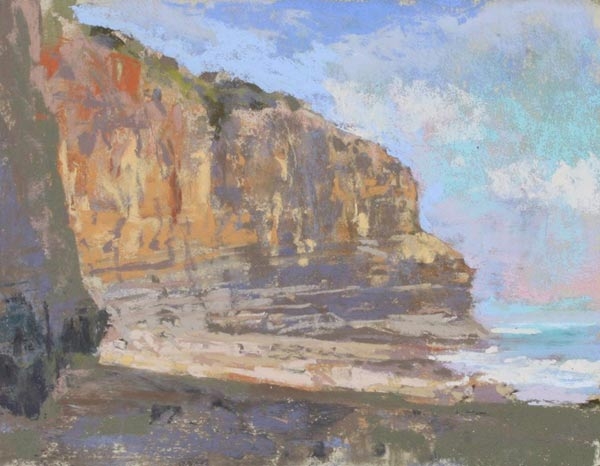
“If you just put down a color, it just sits there,” says Clive Tyler. What does this New Mexico pastelist and instructor at the Plein Air Convention & Expo (PACE) mean by that?
Tyler strongly believes that the underpainting is crucial to a dynamic pastel painting, and because of this, his approach to underpainting will be emphasized during his demonstration at PACE, which will be held April 13-17 in Monterey, California. “Pastelists all have different techniques,” says Tyler. “Some use thin washes with water or alcohol, some lay down complementary colors, others go with a local color. My approach can seem really dramatic in the beginning, and then it gets to a place where if I’m not super-careful, I can lose it. But I know where it can go.”

“Fall River 2,” by Clive Tyler, pastel
He’s fearless about putting down a very dark dark early on — in fact, he sees the silver lining in such a practice. “I can go strong with black, then put a little orange over it for a wonderful cinnamon or rusty color,” says Tyler. He does not adhere to the complement rule, nor any other rule, when putting down the underpainting. For example, if he wants to create depth in the painting using color temperature, he may lay in orange for the foreground, peach for the middle ground, and pink for the background “I very lightly lay down the color that will best enhance the final color,” he says. “If I’m doing a dark evergreen, I’ll lay in burgundy. If I get the right value and temperature, then a little cool green over the top will electrify it and look great.”

“Marsh Study 1,” by Clive Tyler, pastel
So if there’s a field in the middle ground that is catching the light, he won’t just apply a lime green. He’ll first put down a color that plays off the impending lime green. “It reads better if you lay it down along with different colors,” asserts Tyler. “Then it really glows and has a richness that just light green wouldn’t have. It enhances it and gives more of the experience to the viewer. That’s the funny thing about the world. Even a good photo really doesn’t look like what the human being sees. A person sees a lot more and feels a lot more. When I paint, I think about the emotion of it. I want it to be realistic, but emotional.”

A coastal scene by Clive Tyler, pastel
The Taos painter wants the final painting to read from a distance, reward from closer up, and seem abstract when up close. “I like it to be more impressionistic, with broken colors, layers of colors,” says Tyler. “Very close, it’s pretty much a mess of broken color, movement, strokes of the pastel, and bits and pieces floating around. It’s abstract and exciting. When I look at a painting like that, my brain is more stimulated than with a very tight, too-realistic piece.”

A Rio Grande scene by Clive Tyler, pastel
This will be the first time Tyler has attended PACE, though he’s wanted to in past years. The artist always seems to have a lot of deadlines around the end of April, but this year, he planned ahead so he could make the trip to Monterey. Tyler’s not sure what he’ll paint in the demo. He’s thinking about doing a winter river scene, despite the California locale, simply because he is so familiar with that subject matter that he’ll be freed up to talk and demonstrate without the added complication of solving the subject matter.

“Fall River 3,” by Clive Tyler, pastel
One thing is likely: Tyler will use some expressionistic color choices. “I tell my students, ‘Don’t duplicate; create,'” says Tyler. “If a tree wants to be bluer than it looks, make it bluer. If you get more emotional about it, the painting will probably read better.”




